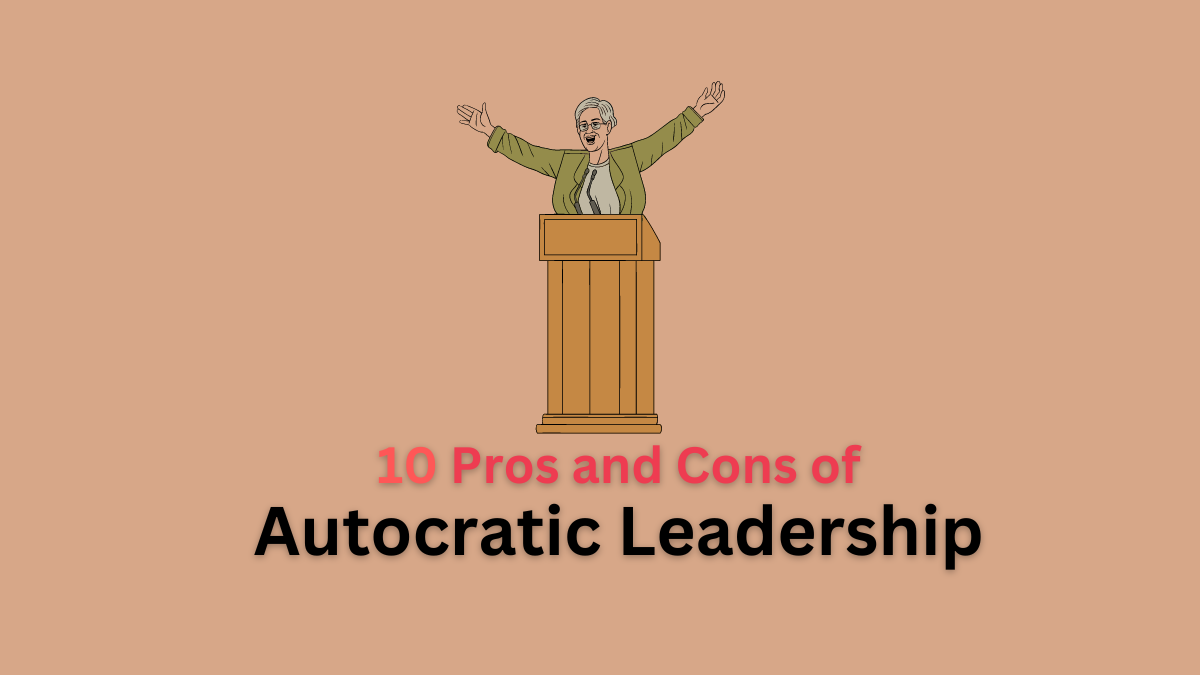Pros and Cons of Autocratic Leadership
Autocratic leadership is a style where a single leader holds all decision-making power, imposing strict rules and procedures. It ensures fast crisis management and clear direction but can lead to micromanagement, low morale, and high dependency on the leader’s skills and ethics.
Here we will discuss the 10 major pros and cons of autocratic leadership style in the workplace, so let’s get started:
Pros of Autocratic Leadership
Let’s explore the 5 main benefits of autocratic leadership style in the workplace:
Fast Decision-Making
Autocratic leadership allows quick decisions because leaders do not need to consult with others. This can be particularly beneficial in crises where immediate action is required.
The streamlined decision-making process can prevent delays and ensure that issues are addressed promptly, maintaining the organization’s stability and functionality.
Clear Direction and Expectations
With autocratic leadership, instructions are explicit and expectations are unambiguous. Employees know exactly what is required of them, which can lead to higher productivity and efficiency.
The clarity reduces confusion and ensures that everyone is on the same page, following a cohesive plan towards the organization’s goals.
Increased Productivity
Due to the clear guidelines and strict oversight, employees often follow best practices consistently, which can lead to fewer mistakes and higher productivity. The regimented structure ensures that tasks are completed in a standardized manner, which can improve overall workflow and output quality.
Effective for Inexperienced Teams
Autocratic leadership can fill the skill gap for inexperienced teams by providing strong guidance and structured instructions.
The leader’s experience and knowledge become a valuable resource that the team can rely on to achieve their tasks effectively. This can be particularly useful in environments where precision and adherence to procedures are critical.
High Safety Standards
In environments where safety is paramount, such as in construction or manufacturing, the rigid structure of autocratic leadership can enforce strict safety protocols.
The emphasis on following rules and procedures minimizes the risk of accidents and ensures that safety measures are consistently applied, protecting both employees and the organization.
Read More: Pros and Cons of Delegation of Authority
Cons of Autocratic Leadership
Now, let’s further explore the five main disadvantages of autocratic leadership in the workplace:
Micromanagement
Autocratic leaders often tend to micromanage, which can stifle employee initiative and creativity. Constant oversight can create a work environment where employees feel undervalued and unable to contribute ideas.
This lack of autonomy can lead to frustration and lower job satisfaction, ultimately impacting employee retention and morale.
Lack of Accountability
Because the leader makes all the decisions, employees may feel less accountable for their work. This can result in a lack of ownership and responsibility among team members, leading to decreased motivation and engagement.
When employees are not held accountable, the quality of work can suffer, and it can be challenging to identify and address performance issues.
Unwelcoming Culture
The success of autocratic leadership heavily depends on the leader’s ethics and behavior. If the leader is unfair or authoritarian, it can create a toxic work environment.
Read More: Pros and Cons of Centralization of Authority
Employees may feel oppressed and demotivated, leading to high turnover rates and a negative reputation for the organization. The culture becomes less collaborative and more about compliance, which can hinder innovation and growth.
Dependence on the Leader
Autocratic leadership creates a dependency on the leader’s skills and knowledge. If the leader is absent or leaves the organization, the team may struggle to function effectively.
The lack of empowerment and development of subordinate leaders can leave the organization vulnerable during transitions, affecting continuity and performance.
Difficult to Correct Poor Results
When results do not meet expectations, it can be challenging to rectify the situation under autocratic leadership. The leader’s dominant role means that failures are often tied to their decisions, making it difficult to implement changes or improvements without completely overhauling the leadership approach. This rigidity can hinder the organization’s ability to adapt and evolve in response to challenges and feedback.
Hence, these are the 10 main pros and cons of autocratic leadership style in the workplace.
Read Next: Pros and Cons of Informal Organization
